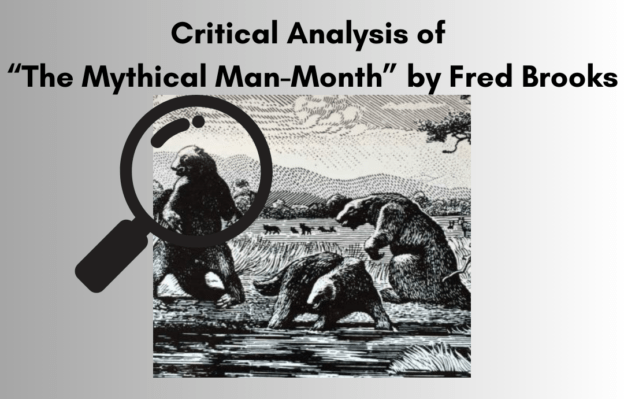Fred Brooks’ seminal work, “The Mythical Man-Month”, has continued to spark discourse and reflection in the realms of software engineering and project management since its publication in 1975. Through a compilation of essays, Brooks explores the human elements and the intricacies of software development projects. This critical analysis aims to dissect the core themes elucidated in the book and examine the influence it has engendered in both academic and practical domains.
Contents
Themes
- Man-Month Fallacy:
- Brooks challenges the conventional wisdom of equating human and temporal resources, arguing against the oversimplification that a job that takes one person a year to complete can also be done by twelve people in a month.
- Communication Overhead:
- With an increase in team size, the channels for communication exponentially increase, posing challenges to coordination and efficiency. Brooks underscores the significance of communication and its impact on project timelines.
- Build One to Throw Away:
- Brooks advocates for a prototype-based approach in software development, acknowledging that the first system is often flawed and the subsequent iteration, built with acquired knowledge, is better suited to the task.
- No Silver Bullet:
- Although not a theme within the book itself but in his subsequent work, Brooks’ assertion that there isn’t a single magical solution to drastically enhance productivity in software development is a concept that stems from the discussions in “The Mythical Man-Month”.
Critical Discussion
“The Mythical Man-Month” provided an introspective look into the software engineering domain at a time when large-scale software project failures were rampant. Brooks’ candid discussion about the IBM System/360 project experiences contributed to a greater understanding of the challenges inherent in software development projects.
The book, however, has faced criticism for potentially being dated as it encapsulates experiences from a specific era of computing. Some argue that the advent of new methodologies like Agile and DevOps, and tools like JIRA or Slack, have alleviated some of the problems Brooks discusses. Nonetheless, the basic premise of human interaction and communication overhead remains as relevant as ever.
Influence
- Agile Methodology:
- Brooks’ ideas prefigured Agile methodologies. His advocacy for small teams, clear communication, and iterative development resonates with the principles of Agile.
- Project Management:
- Concepts from “The Mythical Man-Month” have permeated project management practices, especially in risk assessment, resource allocation, and communication management.
- Educational Curricula:
- The book has found its place in the educational curricula of software engineering and project management courses, bridging the gap between theory and real-world challenges.
- Software Development Tools:
- The problems highlighted by Brooks drove the necessity for better communication and project tracking tools, influencing the development of numerous software project management tools that aim to minimize communication overhead and improve project visibility.
Conclusion
“The Mythical Man-Month” continues to be a vital reference in understanding the complexities of software projects. While some criticisms revolve around its contextual relevance amidst modern tools and methodologies, the fundamental truths about human interaction, communication, and the nature of software development projects it unveils remain pertinent. Through influencing modern methodologies and tools, Brooks’ insights continue to shape the software development landscape, testifying to the enduring relevance of “The Mythical Man-Month”.
